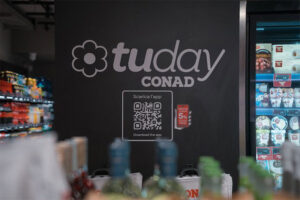Tech Partnership Looks Beyond the Bar Code With Digital Watermarks
Digimarc Corp. , a company that creates invisible digital identifiers for everything from driver’s licenses and bank notes to movies, is teaming up with GS1, which pioneered use of the UPC bar code, to bring “digital watermarking” technology to product packaging.
The marks, which the partners call DW Codes, can be recognized by image-based scanners and smartphone cameras running the right software, making it possible to identify products simply by pointing a scanner in a product’s general direction instead of having to locate and scan a bar code. The idea is to speed up supply chains and point-of-sale transactions.
Digital watermarks are different from the bar codes consumers are accustomed to because they can be printed all over a product’s packaging while remaining invisible to the eye. “A conventional package may have one bar code, or multiple bar codes in a high-volume retail environment,” said Bruce Davis, CEO of Beaverton, Ore.-based Digimarc. “So instead of having six bar codes…. you can have hundreds of bar codes on a package, all imperceptible to the consumer, and readily identified to the scanner.”
Another critical difference is that brand owners who want digital watermarks for their goods will be required to provide detailed information about the products through GS1, a standards body that manages the registry of companies that use UPC bar codes.
The two million companies world-wide registered with GS1 weren’t previously required to register every unique product serial number—which are known as global trade identification numbers, or GTINs—that they generated. There was also no standard way to share those numbers, so information about products would be inconsistent as goods passed through different retail channels. With five billion scans a day, GS1 estimates there are about 700 million to 800 million GTINs in active use.
The detailed registration process required for each item will enable companies to ensure the information about products is consistent from the origin point through to the sale, even if the products change hands or are resold by many different vendors. Consumers also can scan product packaging through smartphones and look up the information originally registered by brand owners or manufacturers.
GS1 and Digimarc say they hope companies will be drawn by the increased ability to control product information and other potential benefits. That may even include help identifying counterfeits.
“The fundamental thing this relationship is trying to deal with is having a set of product information that is going to come with every single code that’s issued, that’s guaranteed from the brand,” said Bob Carpenter, president and CEO of GS1 US. “This is the correct information about the product, and every app will be using the same accurate information to be displayed and given to the consumer.”
Still, the ability to scan a digital watermark will require software upgrades for companies already using image-based scanning, and companies that still use laser scanners will need updated hardware. Each DW code registered will cost an additional $50 a year in fees, but special printers aren’t needed.
It can take years for new technology standards to be widely adopted in global supply chains.
GS1, which pioneered bar codes as identifiers for individual products in 1973, said it wasn’t until the early 1990s that grocery stores in the U.S. started scanning UPC codes for packaged consumer goods. Radio Frequency Identifier, or RFID, tags that are physically attached to goods and transmit data via radio frequencies have been available for years and have been used more frequently as costs have come down. Still, less than half of manufacturers and retailers use RFID technology, according to GS1.
GS1 said it expects that even those companies that adopt DW Codes likely will use them alongside UPC codes for the foreseeable future. That is because many retailers, such as mom-and-pop grocery stores, would need to replace their hardware before use of the code can be more widespread.
“Digital watermarking-based signal processing has for 20 years now been in widespread use in a number of industries,” including government security applications and banking, said Mr. Davis, of Digimarc. “We’re now expanding this science to the commercial marketplace for the global logistics market.”




